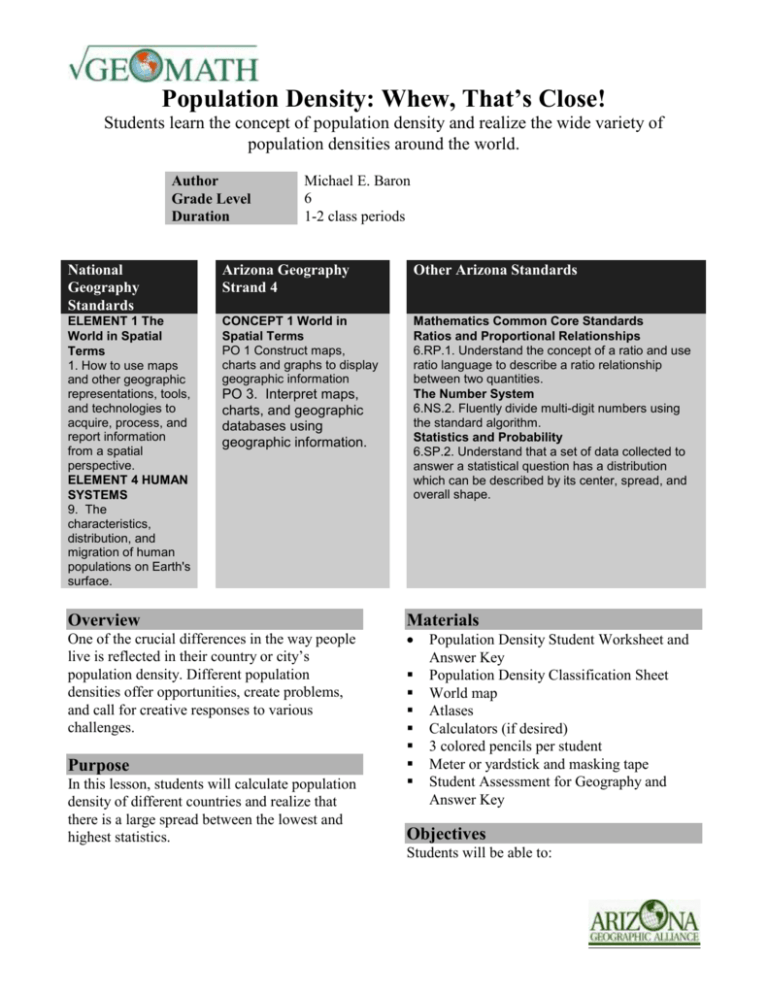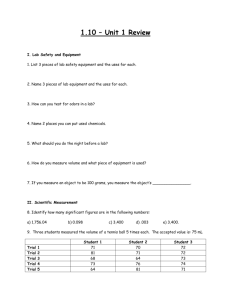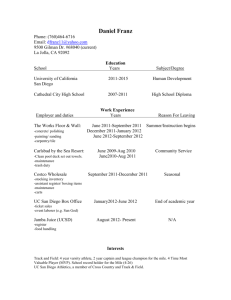LESSON TITLE - Arizona Geographic Alliance
advertisement

Population Density: Whew, That’s Close! Students learn the concept of population density and realize the wide variety of population densities around the world. Author Grade Level Duration Michael E. Baron 6 1-2 class periods National Geography Standards Arizona Geography Strand 4 Other Arizona Standards ELEMENT 1 The World in Spatial Terms 1. How to use maps and other geographic representations, tools, and technologies to acquire, process, and report information from a spatial perspective. ELEMENT 4 HUMAN SYSTEMS 9. The characteristics, distribution, and migration of human populations on Earth's surface. CONCEPT 1 World in Spatial Terms PO 1 Construct maps, charts and graphs to display geographic information Mathematics Common Core Standards Ratios and Proportional Relationships 6.RP.1. Understand the concept of a ratio and use ratio language to describe a ratio relationship between two quantities. The Number System 6.NS.2. Fluently divide multi-digit numbers using the standard algorithm. Statistics and Probability 6.SP.2. Understand that a set of data collected to answer a statistical question has a distribution which can be described by its center, spread, and overall shape. PO 3. Interpret maps, charts, and geographic databases using geographic information. Overview Materials One of the crucial differences in the way people live is reflected in their country or city’s population density. Different population densities offer opportunities, create problems, and call for creative responses to various challenges. Purpose In this lesson, students will calculate population density of different countries and realize that there is a large spread between the lowest and highest statistics. Population Density Student Worksheet and Answer Key Population Density Classification Sheet World map Atlases Calculators (if desired) 3 colored pencils per student Meter or yardstick and masking tape Student Assessment for Geography and Answer Key Objectives Students will be able to: Population Density: Whew, That’s Close! 1. Understand the concept of population density as a ratio. 2. Calculate population density and understand these statistics have a spread of low, medium , and high in countries around the world. 3. Locate selected countries on a world map. 4. Formulate ideas about the ramifications of differences in population densities. Procedures 1. Introduce the concept of population density as a ratio. Demonstrate by marking off a one meter square on the floor and have one student stand in it. Then have 10 students stand in it. Explain that this shows the difference between low and high-density areas. Give the students the definition for population density as number of people per square mile of land. Then discuss that this measurement is a handy statistic for understanding a country, but does this really mean that the people are evenly distributed per each mile? 2. Distribute the Population Density Classification Sheet. Have students work in small groups or individually to guess as to the population density for each of the listed countries. Their choices are high, medium or low. They should fill in the first guess column of the worksheet. Have several students share their responses and the logic for their guesses. If students want to change their first guess, they should enter the new guess in the second guess column. 4. Students proceed to the next country, Brazil, and calculate the population density. Students then independently repeat these steps and complete the Population Density Student Worksheet. 5. Now the students should return to Population Density Classification Sheet and make their final judgment as to high, medium or low population density and fill in the conclusion column. 6. Students should pick one of their 3 colored pencils and color in all of the countries of the countries with high population density. Repeat this step with a different color for the low and medium population density countries. Be sure to remind students to create a key for the colors on their maps. Note: not all students need to agree on what is high, medium, or low. It is important that they see a spread of data. 7. Have a class discussion. Discuss with students as to why different countries have different population densities. Discuss what opportunities might exist in a low-density country that might not exist in a high-density country and vice versa. Also, discuss what problems or challenges might exist in one density but not in one of the other densities. 8. Have students speculate on how houses or dwelling sizes might differ. Speculate further on farm size, parks and open spaces, and transportation. Have students complete Student Assessment for Geography. Assessment 3, Explain the way population density is determined is to take the population of a country and divide it by the number of square miles in the country. Distribute the Population Density Student Worksheet. Do the United States example together. 1. Math: Discuss with the class the conclusions on the classification sheet. Because there are multiple valid ways of classifying the densities, grade holistically. The Population Density Student Worksheet can be graded for correct calculations. Mastery will be considered 80% or higher on the worksheet. Population Density: Whew, That’s Close! 2. Geography: Students should complete the Student Assessment for Geography (6 points) and locate the correctly countries on the world map. Mastery is considered 80% or higher. Extensions Investigate the population density of students’ own town. For instance, Flagstaff has approximately 635 people per square mile, a rate exceeded by a number of countries. The data necessary is available your local city planning department. * Africa - 65 people per square mile * Australia - 6.4 people per square mile The population density of the planet (including all land area) is about 105 people per square mile. If Antarctica is eliminated (since it has zero population density), the world population density rises only to 115 people per square mile. http://geography.about.com Sources http://www.infoplease.com/ Fun Facts to Share with Students About 90% of the earth's people live on 10% of the land. Additionally, about 90% of the people live north of the equator. Population density of the continents: * North America - 32 people per square mile * South America - 73 people per square mile * Europe - 134 people per square mile * Asia - 203 people per square mile http://geography.about.com/od/populationgeogr aphy/a/popdensity.htm




